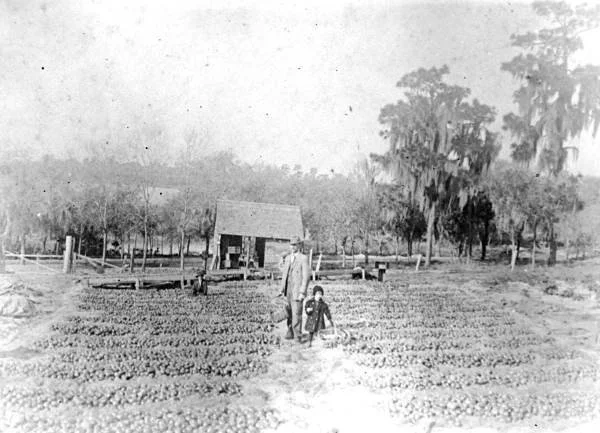Crops & Gardens
Florida pioneers had to provide for themselves and produce most of their own daily necessities. The quality of their life depended on the time they spent working on the farm. They worked in their gardens and fields to provide food for their families to eat and to create goods for trade.
When pioneers came to Florida, they followed certain guidelines to increase productivity and output. Seasonal conditions determined the success of crops in Florida, so guidelines differed throughout the state due to local variances in weather.
Gardens were an important part of every home and were primarily cared for by the women and children of the families. It was believed that gardening stimulated a love of food and nature in children. The act of gardening was considered good exercise and a cure for irregular bowels and moods.
After the Civil War, people ordered most of their garden seeds from catalogs. A year’s worth of seeds cost about $10. Many companies gave their catalogs out for free and offered prizes to those who grew the largest vegetables with their company’s seeds.
On average, a ½ acre garden would feed a family of six. The garden was usually fenced in to keep pests and animals out. The tools used to maintain a garden were “reels and lines,” spades, rakes, hoes, knives, planting sticks or mechanical seeders, hand weeding hooks and pronged cultivators. In the late 1800s, gardens that were large enough were maintained by horse-drawn cultivators and plows. During some months, hotbeds and cold frames were used to adapt certain plants and vegetables to the unaccommodating weather. The only fertilizer used was horse, cow and pig manure.
Man, woman and girl surrounded by field of tomatoes. 1900 (circa). State Archives of Florida, Florida Memory.
Accessed 28 Jun. 2023.<https://www.floridamemory.com/items/show/1764>
Corn and Corn Cribs
Corn was a very profitable crop for Florida pioneers. It was planted from February through April and harvested in the late summer months. After the corn was cribbed, the land could be used for growing peas and sweet potatoes. Peas were sometimes be planted between the rows of corn to be used as a fertilizer and a secondary crop.
When growing corn in a corn crib, it was important that the corn had plentiful airflow. This was ensured by building the corn cribs no more than six feet wide. If it was a double corn crib, it was necessary for there to be a driveway through the center that divided the two and allowed airflow. The land that the corn was grown on greatly affected the crop’s output. Corn grown on an acre of pineland would produce 10 bushels, whereas an acre of hammockland would produce 20 bushels.
Corn was stored in small quantities after it was harvested because it often heated and spoiled easily. A bushel of corn required 2 ½ cubic feet of space for storage, equaling 3,750 cubic feet of storage to store 40 acre’s worth of corn.
Corn cribs were commonly susceptible to rat problems. Often times, the simple act of leaving tools or lumber leaning against the crib wall allowed access to rodents. Many precautions were taken to avoid this problem. Some farmers placed upside down tin pans on the top of the posts outside the crib. Others built their corn cribs at least 20 inches off the ground, and some put wire screens under the floor and between the slats and studs of the walls.
Fodder corn was often grown to be used for livestock feed instead of clover hay. It is estimated that fodder corn cost only $6 per ton, while clover hay cost $8.80 per ton. Another advantage is that fodder corn could often be grown when other grasses and hays were reduced in production due to drought.
Sugar Cane and Making Syrup: How-To Guide for the Pioneers!
Planting: The rows should be dug six inches deep and six inches apart. The canes should be planted in lengths of three or four joints each and buried in three inches of soil. It is important to bury the roots deep to prevent falling at maturity.
Cultivating: Sugar cane should be watered regularly from early spring to mid June. If the soil does not maintain proper moisture, crop production decreases. After June 15, natural rainfall should be adequate.
Harvesting: In late October or early November, it is necessary to strip the dead leaves from the canes in order for the sunlight to reach the ground. This allows the sugar cane to ripen faster. The longer the cane remains in the ground, the greater the output of sucrose and the quality of the syrup. When the cane is cut, the tops should be removed first, then the cane should be cut as close to the ground as possible. Load the cane on to the wagon and transport it to the mill. Sugar cane only has to be replanted every three to four years. The root stays in the ground and ratoons, or grows again from the same root.
Crop Yield: For each acre planted, twenty tons of sugar cane is produced. This generates two- to four-thousand pounds of sugar or 20 gallons of syrup.
Cane Grinding: Most mills in Florida are horse-powered, but steam-powered mills extract more juice from the sugar cane. More juice extracted produces more syrup. Sugar cane is composed of 85 percent juice and 15 percent dry material.
Evaporation of Juice: After the juice is extracted at the mill, it is strained through a cloth stretched over a wooden hoop. Next, it is boiled for several hours. Then the density is measured using a Baume spindle. A Baume spindle is a glass float with a graduated scale. It is placed in a small sample of the syrup, when it sinks to 33 or 34 degrees, the syrup is at the proper density. Upon cooling, the density will be 37 or 38 Baume.

